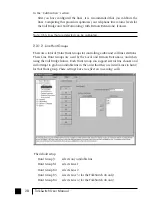
As an example, if 2 units are connected on a LAN, 4 calls can come into all four lines
on one unit and be directed across the LAN to the other unit’s extensions or lines
while 2 intercom calls can also cross the LAN. In the event that an inbound call
cannot be directed across the LAN because all paths are blocked, TalkSwitch will
handle the call according to the ‘Busy at extension’ Call Cascade option for the
selected extension. (See sections 2.3.3.4, 2.3.3.5, 2.3.3.6)
TalkSwitch has been designed to operate optimally when in a networked state. Here
are a few items that have been designed for better network use:
Configuration Settings:
All units are ‘cloned’ with identical settings. In the event that another unit has
‘disappeared’ off the network (adaptor unplugged, LAN connection disconnected,
LAN failure etc...), the system can still handle the calls according to the settings
programmed at other extensions that belong to TalkSwitch units not visible to the
unit handling the call. In the event an extension or voice mailbox cannot be
reached, the caller will hear the following system prompt: “The extension you are
trying to reach is currently unavailable, please try again later.”
Outgoing Line Hunt Groups
By default, when 2 or more units are on a LAN, the system tries placing calls out
on the same TalkSwitch unit the call originates. This avoids using a line across
the LAN on another unit which helps to minimize the LAN traffic and optimizes
the opportunity for all inbound calls to connect across the LAN if required.
Auto Attendants
There are a total of 9 Auto Attendants that are shared by all units on the LAN.
When an Auto Attendant is recorded on any unit, it is then automatically copied
to all other units on the LAN. This design minimizes LAN traffic and also provides
functionality back-up in case a unit or multiple units have ‘disappeared’ off the
network (adaptor unplugged, LAN connection disconnected, LAN failure etc...).
In this event, all systems can still answer inbound calls with the same Auto
Attendant messages).
Voicemail
All Local Extension and Remote Extension voicemail data is stored on the unit
where the extensions normally reside. For example, all greetings, directory names
and voicemail messages for extensions 121-128, 221-228 and mailboxes 420-429
are stored on the TalkSwitch with Unit ID 2. If a unit is completely filled with
voicemail messages, new messages will not be stored on other units. The system
will simply not accept anymore messages for mailboxes belonging to that unit. If
you need more memory, TalkSwitch Memory Cards can be purchased from your
reseller. You can also use the Voicemail Memory Manager to view the memory
usage of each TalkSwitch unit and each mailbox.
17
1.0
Installing TalkSwitch
TS-user manual 7th ED v3 Release.qxd 8/27/02 4:56 PM Page 17
Содержание 48
Страница 1: ...User Guide DESKTOP PHONE SYSTEM...
















































